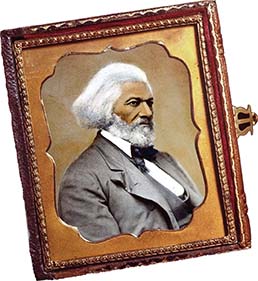SECTION 1: Segregation and Social Tensions

▲ Frederick Douglass
WITNESS HISTORY  AUDIO
AUDIO
Frederick Douglass Laments the Color Line
In 1883, Frederick Douglass, the famous black leader and former runaway slave, addressed a gathering of African Americans in Louisville, Kentucky. Twenty years had passed since Lincoln had issued the Emancipation Proclamation, yet, as Douglass observed, African Americans had not realized their hopes for equality.
“Though we have had war, reconstruction and abolition as a nation, we still linger in the shadow and blight of an extinct institution. Though the colored man is no longer subject to be bought and sold, he is still surrounded by an adverse sentiment, which fetters all his movements. In his downward course he meets with no resistance, but his course upward is resented and resisted at every step of his progress….”
—Frederick Douglass, address in Louisville, Kentucky, 1883
Objectives
- Assess how whites created a segregated society in the South and how African Americans responded.
- Analyze efforts to limit immigration and the effects.
- Compare the situations of Mexican Americans and of women to those of other groups.
Terms and People
- Jim Crow laws
- poll tax
- literacy test
- grandfather clause
- Booker T. Washington
- W.E.B. Du Bois
- Ida B. Wells
- Las Gorras Blancas
NoteTaking
Reading Skill: Summarize Record the ways in which different groups challenged Reconstruction.

African Americans
Challenging Discrimination
Mexican Americans
Why It Matters During Reconstruction, the federal government sought to secure equal rights for African Americans. By the time of the Gilded Age (1877–1900), however, African Americans and other minorities experienced a narrowing of their rights. This turn away from equality for all had a lasting impact on society in the United States. Section Focus Question: How were the civil and political rights of certain groups in America undermined during the years after Reconstruction?
African Americans Lose Freedoms
Following the disputed presidential election of 1876, President Hayes removed federal troops from the South. This action allowed southern states to reassert their control over African Americans without concern about federal intervention. Southern governments enacted various measures aimed at disenfranchising, or taking away the voting rights of, African Americans and enacted Jim Crow laws that kept blacks and whites segregated, or apart.
States’ Governments Limit Voting Rights
The Fifteenth Amendment, which became part of the United States Constitution in 1870, prohibited state governments from denying someone the right to vote because of “race, color, or previous condition of servitude.” After Reconstruction, southern states got around this




